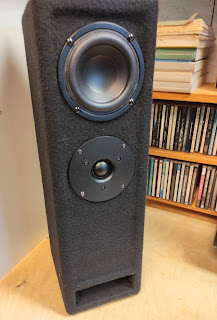Part1
Today some vintage PMC LB1 studiomonitors did arrive at my desk.For those unknown: just follow the link for a description of these UK manufactured benchmark loudspeakers, developed by some former BBC employees.
They came accompanied with a assorted collection of 'spare' tweeters and woofers.
Upon first test nothing worked as it should: we quickly found that both 1 and 2 +/- connection of the speakons where paralleled. Now that is a bit unusual, as in pro-audio we use a NL4 speakon to feed a loudspeaker with a high/low split signal. Nowadays the majority of prof. amps have 2 channels feeding 1 speakon. So the box effectively shorts the 2 channels. Not good. Oh well..easily sorted.
Still not very good sound. So let's open it up: and behold and wonder some fire has been inside.
Now this really made me curious. I know the loudspeakers have been driven with Bryston 4B amps. (Not to shabby!) So underpowered clipping amp couldn't be the reason.
So let's investigate...
First thing I did was try to find a schematic for this cross-over online. No luck. So I drew it up myself:
Now to get an idea of the design philosophy we examine the values of the components closely. Immediately the doubling of C1 vs C2 (6.8uF) springs out, which will point to a textbook LinkwitzRiley 24 dB filter. In those days modelling software (like LinearX Leap) was available but apparently not wide spread. (I did acquire my copy somewhere in 1996). So we could investigate this pointer further. I de-soldered the 2 coils and measured them. Not very accurate, but both values and even more their ratio (1:4.5) prove this indeed it is a textbook LR filter.
To determine for what crossover frequency they designed that filter we have to do a bit of guess work. because you will have to know the impedance with which this filter is terminated. What if they just took the (DC !) 6 ohm resistance that is mentioned on the tweeter ? (of course this is not correct but read on..) In that case the crossover will work as a (electrically!) perfect 24dB LR crossover at 2100 Hz.
Anybody who has dabbled a bit in passive crossover design knows the horrors: components all interact with each other, are never ideal (parasitic inductance / capacitance) and the terminating impedance is never a constant (ohmic) resistance. So yes, changing f.e. capacitors with different brands (with the SAME value, duh) will have an impact on the sonic behavior of a filter. But that is a different story.
First let's measure the tweeters to see if that terminating resistance indeed is more or less a constant 6 ohms..
And yes: the green line is an impedance measurement of the raw driver. That is rather flat to begin with so one immediately thinks: ferrofluid . Indeed in the '90's that was considered quite the bomb. Some manufacturers did use ferrofluid in everything (even 15" speakers, bad idea!)
One of the 'spare' tweeters had some note saying "possibly faulty", so I opened it up to find out.
Now opening up drivers and in general reconing or refitting new membranes is NOT a good idea (with nowadays manufacturing tolerances) but that is an other rant, this tweeter was 'possibly' faulty anyway:
Yes, JL (in 2015) this tweeter is definitely faulty..I might even say totally foobarred.. But also filled with (a bit dried) ferrofluid so: confirmed!Now what type/brand tweeter would this be, because they look awfully familiar?
And, suprise, suprise: when I pulled away some PMC branding sticker I found the original VIFA D27TG35 sticker. Take note of that exact number because this is remarkable!: In that same era (somewhere in the '90's) I did design and manufacture a small multipurpose loudspeaker (build maybe a 100 units or so) with that exact same tweeter. When they went out of production I bought the remaining stock and that was the end of that build. (fairly recently I did a restoration of one of the installs-->)And no, some Peerless or (Vifa rebranded) tweeter with a similar number will not be a replacement! But you can have your own opinion: nobody will get hurt..
Onwards with the filter, cause still some components need to be explained: more precisely the burned resistor(s). First one is a series resistor with a paralleled capacitor. This will serve as a attenuator for the tweeter and also as a slight top boost (ferrofluid, y'ken) with +3dB point at 9khz. Fair enough. But it will make the filter 'see' a higher load.
But what's that 100nF (with series 8 ohm) doing there? Those values make no sense at all, it does precisely nothing in the audible band. Also as an zobel network (to stabilize amp load) it is nonsense in that position..oh well.. brainfart from the designer??
So this leaves us the one resister that is paralleled with the combined load of tweeter and attenuator to get back to the correct load for the LR filter. From a designers perspective this is an awful solution: that resistor will get hammered with a lot of power, so no wonder it is burned.
Previous repairs show a (also way to small) installed 13 ohm resistor. Now that's an odd value. Not likely in my opinion.
Back to the measurement above: if I insert a 10 ohm resistor and re-measured the tweeter with attenuator I got that yellowish line: an almost flat, straight out 6 ohms, which brings us back to the desired, flat line 6ohm for our LR network topology...
Now hows that for loudspeaker forensics?




















































